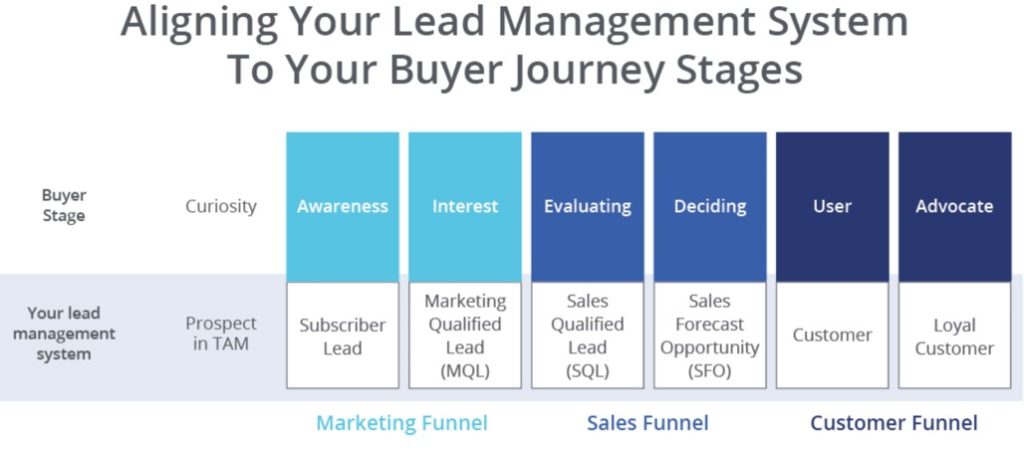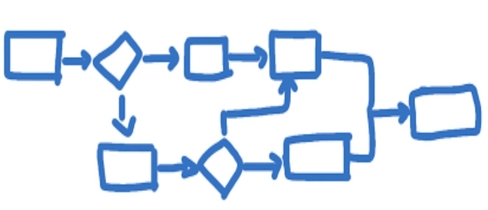[Part 3 of 3]
In Part 1 of this series I introduced the three-funnel segment approach for maximizing your commercial engine. In Part 2, I showed you how the Commercial Engine maps to the Buyer Journey. Here in Part 3, I’ll provide the last piece of the puzzle – aligning both your 3 Funnel Segments and the Buyer Journey with your Lead Management System. As a reminder, the commercial engine is the company’s system for obtaining leads, selling, and serving the customer, and excludes manufacturing, HR, finance, IT, and facilities.
Note: This blog is part 3 of a three-part blog series: Designing your Commercial Engine for Success
Part 1: Understanding the 3 Funnel Segments of your Commercial Engine
Part 2: Mapping the Buyer Journey to your Commercial Engine Funnel
Part 3: Aligning Lead Management, the Buyer Journey, and 3 Funnels
Your lead management system spans all the way from obtaining the lead through earning customer loyalty. For your convenience, the image below is repeated from Part 2. It shows the mapping between your 3 Commercial Engine Funnels and the Buyer Journey.

Buyer Journey Stages
Tying in your lead management system is the next step. I find many small to mid-sized manufacturing companies do not have an efficient lead management system. Studies support this assertion. The fact is, lead management systems do not keep up with company growth – the quantity of leads and sales opportunities have expanded beyond the capacity of simple spreadsheet-based systems. Disorganization causes errors: leads are then left unqualified, nurturing rarely takes place, and buyers leak from the system. The end result is loss of market share and a significant revenue hit to the business.
How do I define the optimum lead management system? One where all leads receive the appropriate amount of attention from the right resource, funnel velocity is maximized, customer acquisition cost is appropriate, sales win rate is above industry average, and no buyers leak out.
Putting the pieces together
Ultimately, you cannot design an efficient commercial engine without a well-defined lead management system that matches the buyer journey. This system must be easily managed by all responsible staff through the CRM or it will leak out buyers like a sieve. Luckily, aligning your lead management system to the three funnel segments and six buyer stages is not difficult. In fact, it’s intuitive, as laid out in the following graphic.

The image above is the culmination of this 3-blog series. It looks simple enough, but adhering to the structure might require changes to your commercial team’s responsibilities, the internal processes you follow and the software you use. Such organizational change is never easy. The terms listed in the second row, “Your lead management system,” are those found in many of today’s CRM systems – subscriber lead, marketing qualified lead (MQL), sales qualified lead (SQL), sales forecast lead (SFO), customer, and loyal customer. The terms you use in your current system probably have some similarities – if not in wording at least in function.
Whatever words you use, match up your lead management stages to the appropriate buyer stages as shown. Each department – marketing, sales, and service – should have at least two stages so they can create goals and processes for each. Dividing large tasks into smaller improves efficiency. Your three departments will truly understand their roles, and your funnel health will improve.
The graphic below shows the steps of the lead management system I recommend. It includes two additional steps I have not mentioned yet, the Open Marketing Lead (OML) and the Open Sales Lead (OSL). These two steps are re-qualification gates where a lead is contacted directly with the result of moving forward, backward or being removed from a funnel segment.
The best way to explain this lead management system is to take a project from start to finish with a hypothetical customer who touches every step. I will use a fictional company called ABC Custom Truck Works to help illustrate the lead management system. ABC manufactures and sells customized vans and pickup trucks for trades (landscapers, electricians, carpenters). We discuss ABC extensively in our book, MarketMD Your Manufacturing Business. Here is how ABC carries a project through their system from start to finish.
The Otis Lead:
The marketing department at ABC Custom Truck Works conducts a lead generation campaign and receives an email address from Otis Black Dog Carpentry.
Step 1 Subscriber Lead = Awareness Stage: By providing ABC with its email address, Otis has given permission to market to them. Otis becomes a subscriber lead and all interaction from this point forward is logged in the CRM. ABC’s goal at this stage is to obtain a phone number so that a person-to-person conversation to qualify Otis can take place. Until then ABC can only send digital content.
ABC’s marketing department nurtures the subscriber for a few weeks with compelling, relevant digital content. Otis eventually follows a call to action (CTA) on an ABC nurturing email and provides their name and telephone number in exchange for receiving a download of a case study. Otis now becomes an Open Marketing Lead (OML).
Step 2 OML: Open Marketing Leads must be qualified by the marketing team quickly since ABC wants leads to remain OMLs for as short a time as possible. After the qualification call, marketing will determine whether the lead is sales ready and should be sent on to the sales funnel segment, is not valid and should be removed and placed in a “dead” database, or should stay in the marketing funnel segment to be nurtured.
An ABC marketing representative calls Otis within five minutes of receiving their contact information because research shows that responding within 5 minutes means a 90 percent chance of reaching the contact. During the conversation with the Otis representative, ABC’s marketing rep discovers the contact’s role in the company, Otis’ basic needs, and the purchasing time frame. The ABC marketing rep judges Otis not to be considering entering the buying cycle, and so qualifies them as a Marketing Qualified Lead (MQL). The lead stays in the marketing funnel segment to be nurtured by marketing.
Step 3 MQL = Interest Stage: The marketing department continues to nurture Otis. During the next 12 weeks, Otis receives regular, relevant content. Reports from ABC’s marketing automation software shows Otis has recently increased its number of downloads and website visits. An ABC marketing rep calls to requalify and finds that Otis’ interest level has indeed increased. Otis is deemed to be considering entering the buying cycle, is elevated to OSL status, and is moved from the marketing funnel segment to the sales funnel segment.
Step 4 OSL: An Open Sales Lead alert informs the local sales person responsible for closing business that a new sales ready lead has arrived. The sales person quickly reviews the notes in CRM and contacts the OSL for further evaluation. Otis is called “open” because sales has not re-qualified them yet. Sales has the choice of accepting the project as a Sales Qualified Lead, or rejecting it to return Otis back to marketing as an MQL. After the conversation with Otis, the sales person judges that Otis is considering entering the buying cycle and qualifies them as an SQL.
Step 5 SQL = Deciding Stage: When sales accepts the lead, Otis becomes a Sales Qualified Lead and remains in the sales funnel segment. The local sales rep now has primary responsibility for working the project and closing the deal. Marketing continues to send appropriate content (double checking with sales before sending any content that might interfere with the selling process). The project heats up, and the sales person goes to visit Otis to further advance the sale.
Step 6 SFO Stages = Negotiating Stage: During the visit, the sales person determines that Otis is in the buying cycle, and ready to receive a quote. Sales returns to present the quote in person and enters the opportunity in the CRM with a probability of closure of 25 percent as well as the estimated revenue amount, equipment list, and prognosis date for closure. Once the Otis project is given a probability and prognosis, it becomes a Sales Forecast Opportunity (SFO), and is now on the radar of the production team to make sure product can be ready if the sale closes.
After additional contact with Otis, the sales person moves the project to 50 percent probability of closing. Since the product quoted to Otis is standard product, the production and sales management teams decide to consider Otis as 50 percent of an order, combines it with another similar 50 percent probability order, and begins to build one unit “to forecast” to be completed by the earlier prognosis date of the two.
Over the next week, the Otis project continues to advance as they begin pursuing funding. The sales person moves Otis to 70 percent probability of closing and adjusts the prognosis date after an encouraging face-to-face review of a revised quote. Production and sales management take notice. Then, two days later Otis signs the quote and provides a PO number. Now Otis is set to 90 percent probability of closing in the CRM. Production has been tracking the progress, and has equipment scheduled to be ready by the delivery date.
Step 8 – Customer = User Stage: Otis provides the down payment, the project moves to 100 percent probability, product is shipped to them, and they are now considered a customer. Otis enters the customer funnel segment, and the service department assumes the primary responsibility for supporting them. Under the guidance of the service department, the product is commissioned, Otis personnel are trained in the operation, maintenance, and parts ordering, and over time their satisfaction grows. Service and marketing continue to nurture Otis toward loyalty. Marketing sends user-related content every three to six weeks. Sales checks in periodically as well.
Step 9 – Loyal Customer = Advocate Stage: A year later, ABC Custom Truck Works places Otis on the list of loyal customers because it becomes apparent that Otis buys all they can from ABC, is impervious to competition, and recommends ABC to others.
Aligning lead management, the buyer journey, and the commercial engine is a proven way to rev up your business:
- Your commercial system makes sense to your staff, with clear roles and responsibilities. Your teams will be in a position to optimize their processes and improve efficiency.
- Your funnel segments will become healthier, with higher funnel velocities and fewer leaks.
- Your leadership team will be able to review metrics on all three funnel segments instead of just the SFOs (where leaders tend to concentrate). Looking further upstream at the marketing funnel segment and downstream to customer loyalty funnel segment will improve revenue prediction and stability.
- Your customers and leads will experience greater service and support, delivering a higher percentage of sales and loyalty.
Reorganizing your commercial engine in this way is no small matter. But organizing internal company systems to match the external market is a proven methodology that can jumpstart your commercial engine.
chip
Latest posts by Chip Burnham (see all)
- Value Pricing Retains Both Customers and Profits - November 14, 2018
- Voice of the Customer – Needs Research - October 17, 2018
